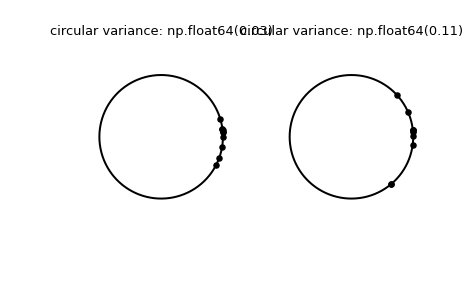circvar#
- scipy.stats.circvar(samples, high=6.283185307179586, low=0, axis=None, nan_policy='propagate', *, keepdims=False)[source]#
Compute the circular variance of a sample of angle observations.
Given \(n\) angle observations \(x_1, \cdots, x_n\) measured in radians, their circular variance is defined by ([2], Eq. 2.3.3)
\[1 - \left| \frac{1}{n} \sum_{k=1}^n e^{i x_k} \right|\]where \(i\) is the imaginary unit and \(|z|\) gives the length of the complex number \(z\). \(|z|\) in the above expression is known as the mean resultant length.
- Parameters:
- samplesarray_like
Input array of angle observations. The value of a full angle is equal to
(high - low).- highfloat, optional
Upper boundary of the principal value of an angle. Default is
2*pi.- lowfloat, optional
Lower boundary of the principal value of an angle. Default is
0.- axisint or None, default: None
If an int, the axis of the input along which to compute the statistic. The statistic of each axis-slice (e.g. row) of the input will appear in a corresponding element of the output. If
None, the input will be raveled before computing the statistic.- nan_policy{‘propagate’, ‘omit’, ‘raise’}
Defines how to handle input NaNs.
propagate: if a NaN is present in the axis slice (e.g. row) along which the statistic is computed, the corresponding entry of the output will be NaN.omit: NaNs will be omitted when performing the calculation. If insufficient data remains in the axis slice along which the statistic is computed, the corresponding entry of the output will be NaN.raise: if a NaN is present, aValueErrorwill be raised.
- keepdimsbool, default: False
If this is set to True, the axes which are reduced are left in the result as dimensions with size one. With this option, the result will broadcast correctly against the input array.
- Returns:
- circvarfloat
Circular variance. The returned value is in the range
[0, 1], where0indicates no variance and1indicates large variance.If the input array is empty,
np.nanis returned.
Notes
In the limit of small angles, the circular variance is close to half the ‘linear’ variance if measured in radians.
Beginning in SciPy 1.9,
np.matrixinputs (not recommended for new code) are converted tonp.ndarraybefore the calculation is performed. In this case, the output will be a scalar ornp.ndarrayof appropriate shape rather than a 2Dnp.matrix. Similarly, while masked elements of masked arrays are ignored, the output will be a scalar ornp.ndarrayrather than a masked array withmask=False.References
[1]Fisher, N.I. Statistical analysis of circular data. Cambridge University Press, 1993.
[2]Mardia, K. V. and Jupp, P. E. Directional Statistics. John Wiley & Sons, 1999.
Examples
>>> import numpy as np >>> from scipy.stats import circvar >>> import matplotlib.pyplot as plt >>> samples_1 = np.array([0.072, -0.158, 0.077, 0.108, 0.286, ... 0.133, -0.473, -0.001, -0.348, 0.131]) >>> samples_2 = np.array([0.111, -0.879, 0.078, 0.733, 0.421, ... 0.104, -0.136, -0.867, 0.012, 0.105]) >>> circvar_1 = circvar(samples_1) >>> circvar_2 = circvar(samples_2)
Plot the samples.
>>> fig, (left, right) = plt.subplots(ncols=2) >>> for image in (left, right): ... image.plot(np.cos(np.linspace(0, 2*np.pi, 500)), ... np.sin(np.linspace(0, 2*np.pi, 500)), ... c='k') ... image.axis('equal') ... image.axis('off') >>> left.scatter(np.cos(samples_1), np.sin(samples_1), c='k', s=15) >>> left.set_title(f"circular variance: {np.round(circvar_1, 2)!r}") >>> right.scatter(np.cos(samples_2), np.sin(samples_2), c='k', s=15) >>> right.set_title(f"circular variance: {np.round(circvar_2, 2)!r}") >>> plt.show()
